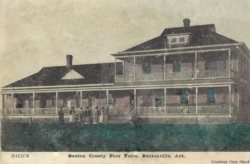Benton County Poor Farm
| Benton County Poor Farm | |
|---|---|
 | |
| Established | 1857 |
| Opened | 1858 |
| Closed | 1951 |
| Current Status | Demolished |
| Location | Bentonville, AR |
| Alternate Names | |
History[edit]
In April of 1857, the court found it necessary to establish a poorhouse in Benton County. A commission was formed to find a location for the county poorhouse. A sum of $1200 was set aside for the purchase of the property when a suitable location was found. In January of 1958, the commission reported that a 45 acre site had been found just north of Bentonville. The property had a spring, a log cabin (without floor), 10 cultivated acres, and 4 acres in wheat. This land was purchased for $300 from William Clements and a survey of the property was done. The county then built the other necessary buildings on the property and moved the paupers of the county to the farm, placing them under the care of a superintendent.
When the new courthouse was completed in 1875, the temporary courthouse building was removed and resituated on the poor farm. The building was disassembled and reassembled on the the property by William Stewart and J, V. Lee at a cost of $330. An additional $120.50 was given to James Haney to be used for fitting the building out. The poor farm housed an average of about 8 to 10 people at a time. It went by several other names, including the poorhouse, or the pauper's farm. In 1907, a special act of the general assembly changed the name to the Benton County Home. The people who lived at the poor farm were called inmates or paupers, which were common terms for the poor at the time.
In November of 1905, the Benton County Home was moved to a new location about where the Benton County Services building is located on Highway 102 West. The inmates were taken care of by a contract that provided a set amount day per inmate. In 1906, W. R. Ford was awarded a contract for 30 cents a day, which was intended to also provide board, clothing, and medical treatment. The lowest bid, which wasn't accepted, had been 15 cents. The contract system left the inmates at the mercy of the contractor, so the system was later abandoned, and a superintendent was hired for the county home. The County Home was open until the 1940s or 1950s when other facilities took its place.